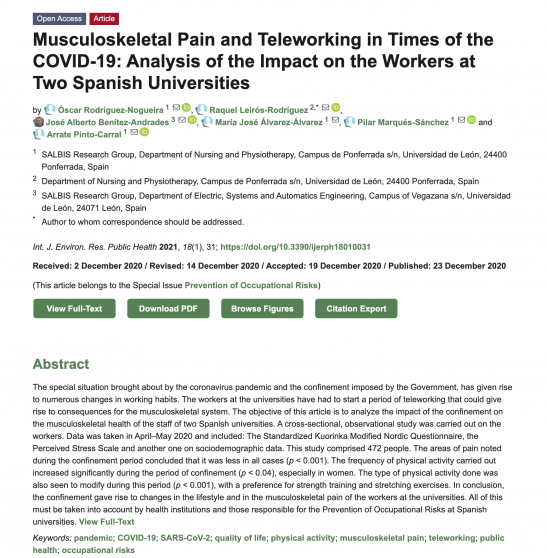Musculoskeletal Pain and Teleworking in Times of the COVID-19: Analysis of the Impact on the Workers at Two Spanish Universities
1 SALBIS Research Group, Department of Nursing and Physiotherapy, Campus de Ponferrada s/n, Universidad de León, 24400 Ponferrada, Spain
2 Department of Nursing and Physiotherapy, Campus de Ponferrada s/n, Universidad de León, 24400 Ponferrada, Spain
3 SALBIS Research Group, Department of Electric, Systems and Automatics Engineering, Campus of Vegazana s/n, Universidad de León, 24071 León, Spain
* Author to whom correspondence should be addressed.
Int. J. Environ. Res. Public Health 2021, 18(1), 31; https://doi.org/10.3390/ijerph18010031
Received: 2 December 2020 / Revised: 14 December 2020 / Accepted: 19 December 2020 / Published: 23 December 2020
(This article belongs to the Special Issue Prevention of Occupational Risks)
The special situation brought about by the coronavirus pandemic and the confinement imposed by the Government, has given rise to numerous changes in working habits. The workers at the universities have had to start a period of teleworking that could give rise to consequences for the musculoskeletal system. The objective of this article is to analyze the impact of the confinement on the musculoskeletal health of the staff of two Spanish universities. A cross-sectional, observational study was carried out on the workers. Data was taken in April–May 2020 and included: The Standardized Kuorinka Modified Nordic Questionnaire, the Perceived Stress Scale and another one on sociodemographic data. This study comprised 472 people. The areas of pain noted during the confinement period concluded that it was less in all cases (p < 0.001). The frequency of physical activity carried out increased significantly during the period of confinement (p < 0.04), especially in women. The type of physical activity done was also seen to modify during this period (p < 0.001), with a preference for strength training and stretching exercises. In conclusion, the confinement gave rise to changes in the lifestyle and in the musculoskeletal pain of the workers at the universities. All of this must be taken into account by health institutions and those responsible for the Prevention of Occupational Risks at Spanish universities. View Full-Text

